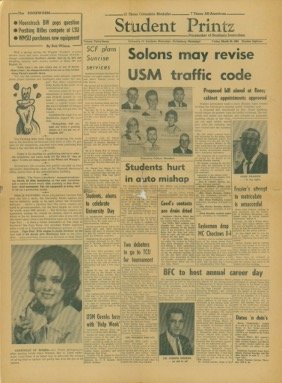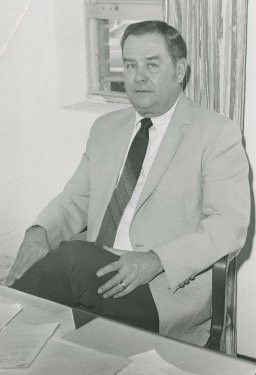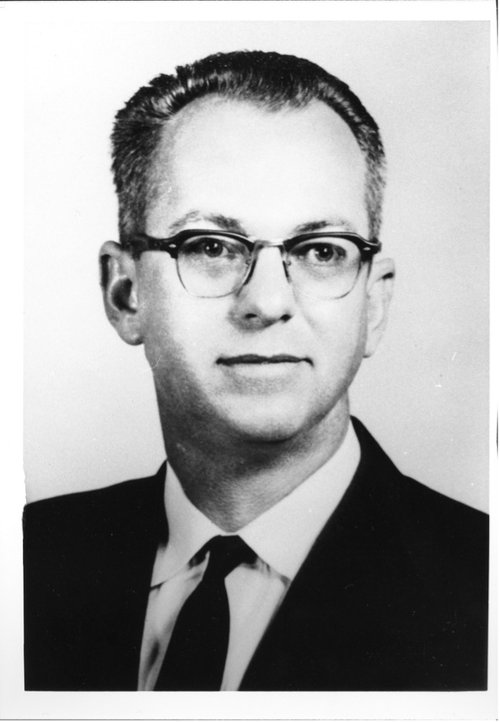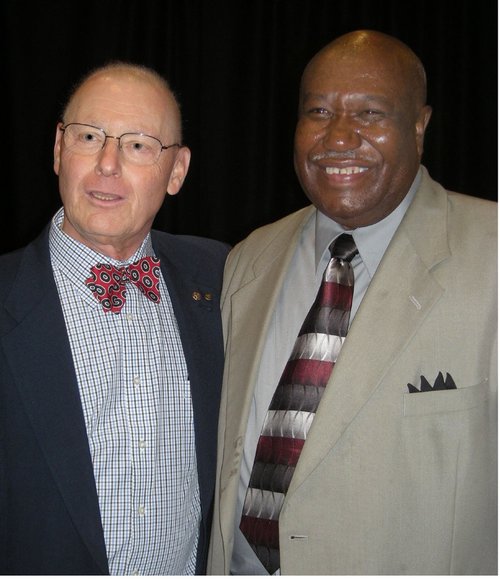University of Southern Mississippi History Project
Figure 1. Photo of John Frazier (Photograph from Student Printz, Page 1, 20 March 1964, Box 19, RG032 University Union and Student Activities, Digital Collections, The University of Southern Mississippi. https://usm.access.preservica.com/uncategorized/IO_9c9a525d-d79d-49c4-b653-ab03fe251540/.)
John Frazier: The Untold Story
By Abigail Bowers and Hailey Pearson
Between Clyde Kennard’s attempt to integrate Southern Miss in 1958 and the university’s integration in 1965, there was another attempt that is rarely discussed. On March 9, 1964, John Frazier tried to enroll in a graduate program, but was turned away. The Student Printz described this affair as having “no incident or crowds,” but Frazier said in an oral history that a brick was thrown at him and he needed medical attention. Frazier also mentioned that the Governor and Lieutenant Governor were there along with administrators and USM President William McCain.
John Frazier was inspired by Clyde Kennard and wanted to “take up his struggle” after the day he died. Frazier knew the risks involved and persevered. Sadly, his story has been overlooked and the dangers he faced are unrecognized even today. One reason for this is because for years there was no physical evidence from 1964 of what he experienced, and there still is no paper evidence in the archives of his perspective. Frazier’s story has been silenced from the beginning, both by archival silences and censorship on campus.

Figure 2. Student Printz coverage of Frazier (Photograph from Student Printz, Page 1, 20 March 1964, Box 19, RG032 University Union and Student Activities, Digital Collections, The University of Southern Mississippi. https://usm.access.preservica.com/uncategorized/IO_9c9a525d-d79d-49c4-b653-ab03fe251540/.)
Weeks after Frazier attempted to integrate Southern Miss, The Student Printz ran a story on the incident. It was fairly tame and simply mentioned that Frazier’s effort was unsuccessful, that there were no crowds, and he was not planning on taking legal action. There was no mention of the danger Frazier faced or his injury. Still, this short and unassuming description of the integration attempt was deemed inappropriate by the McCain administration. After the paper hit stands, it was immediately confiscated and taken directly from students’ hands. There was no explanation as to why. The editor of the Printz, Charles Kershner, later described the fear he and his colleagues felt at the time as they managed to hide one copy of the offending edition. That copy, the only one remaining that has the Frazier story, is now located in the McCain Library and Archives on campus.

Figure 3. Photo of William Grantham, 1984. (Photograph from William Rader Grantham, 1984, Box 204, RG002 - PC7201, People, RG002 University of Southern Mississippi Photographs, Digital Collections, The University of Southern Mississippi. https://usm.access.preservica.com/uncategorized/IO_ee3196cc-b6fb-4efe-836c-a8ab5762d3a3)
According to Kershner, William McCain, the president of USM, gave the order for the seizure of the Student Printz less than twelve hours after he gave his speech to the Central Lions Club titled “Freedom.” During this speech he discussed the overarching threats he believed posed a severe danger to American freedom and democracy. The greatest threat McCain identified was the infiltration of communism. Notably, he linked African Americans to this threat by claiming they were susceptible to communism due to their history of oppression by white Americans. In short, McCain attempted to undermine the legitimacy of white and black Americans advocating for equality by associating them with the widely held fears of the time.
President McCain ended his speech in a patriotic fervor, claiming to stand with and advocate for freedom in America. During his final statements, McCain specifically claimed that he desired to “preserve freedom of speech, of news, of education.” Ironic considering he gave his order to censor the Student Printz almost directly after giving this speech.
Rader Grantham, the Dean of Men and Women’s Affairs, worked with the campus police to gather all copies of the student paper. They entered classrooms, taking papers from students and staff, as well as the Student Printz’s office. They took all the copies they had collected and burned them at the smokestack on campus (now the Powerhouse restaurant). This has been the only known case of outright censorship in the Student Printz.

Figure 4. Photo of Erle Johnston Jr., Director of the Sovereignty Commission in 1964. (Photograph from Erle Johnston, circa 1950s, Box 10, Folder 17, M319 Johnston (Erle E., Jr.) Papers, Digital Collections, The University of Southern Mississippi. https://usm.access.preservica.com/uncategorized/IO_7329eb90-ccd9-4769-acc2-9afbcfe94d94.)
Earlier that month the Director of the Sovereignty Commission, Erle Johnston Jr., reached out to President McCain in order to assist him in preventing Frazier from reapplying to USM. The Sovereignty Commission was a pro-segregationist organization that worked to curb the growing Civil Rights movement. The Commission had been keeping tabs on Frazier as early as 1960, when he was only 17 years old. After several of Frazier’s attempts to attend USM failed, McCain received a letter from Erle Johnston containing the Sovereignty Commission’s ‘trump card’ against Frazier. The letter instructed McCain to inform Frazier that should he attempt to integrate USM again, the Commission would publicly accuse him of being a homosexual in order to discredit him. At the time, this was a tactic used to discredit members and leaders of Civil Rights organizations and potentially ruin their livelihoods.

Figure 5. Photo of Kershner and Frazier (Photograph from Tisdale, David. “Mass Communication and Journalism Hall of Fame Member Kershner Dies.” The University of Southern Mississippi, March 23, 2013. https://www.usm.edu/news/2013/release/mass-communication-and-journalism-hall-fame-member-kershner-dies.php.)
Forty-three years after these events, Charles Kershner, the editor of the Printz in 1964, gave a speech at the School of Communication’s Symposium on Social Justice. He discussed Frazier’s integration attempt and the censorship of the Printz, and ended by inviting John Frazier to the stage to tell his story. While Frazier had previously told his story in an oral history, he had not spoken at the University before.
It is important to note that Kershner did not tell Frazier’s story for him because he knew the importance of hearing the events from Frazier directly. Sadly, the speech Frazier gave is missing from the archival record. Because of this, the only physical evidence of the March 1964 events in the McCain Library and Archives on campus are Kershner’s speech and the two versions of the Student Printz. Frazier’s oral history is a wonderful resource, but the lack of physical documents relating to his story causes a deep archival silence.
In order to combat archival silences in the future, it is imperative for physical materials to be submitted to the McCain Library and Archives whenever possible. If you are in any student organization focused on diversity or inclusion that would be willing to submit papers to the archive, please contact Uriah Jenkins (Joshua.jenkins@usm.edu) or Lorraine Stuart (lorraine.stuart@usm.edu) to make arrangements.
Bibliography
Associated Press. “Without Usual Application Student Can’t Be Enrolled.” Paper Unknown, March 6, 1964. https://egrove.olemiss.edu/jws_clip/260?utm_source=egrove.olemiss.edu%2Fjws_clip%2F260&utm_medium=PDF&utm_campaign=PDFCoverPages
Erle Johnston, circa 1950s, Box 10, Folder 17, M319 Johnston (Erle E., Jr.) Papers, Digital Collections, The University of Southern Mississippi. https://usm.access.preservica.com/uncategorized/IO_7329eb90-ccd9-4769-acc2-9afbcfe94d94.
Frazier, John, interview by Nishani Frazier, March 21, 2004, Digital Collections at The University of Southern Mississippi.https://usm.access.preservica.com/uncategorized/SO_e61904c7-9195-4006-8210-37d71488bf11.
Freedom, 1964, Box 4, Folder 29, M393 McCain (William D.) Pamphlet Collection, Digital Collections, The University of Southern Mississippi. https://usm.access.preservica.com/uncategorized/IO_5a6655a3-5932-4fa1-98f1-72968a11bae7.
Memo to Governor Barnett on NAACP, Greenville, Mississippi, page 2, 11 March 1960, SCR ID # 2-72-1-48-2-1-1, Sovereignty Commision Online, Mississippi Department of Archives and History. https://da.mdah.ms.gov/sovcom/result.php?image=images/png/cd04/028723.png&otherstuff=2|72|1|48|2|1|1|28207|.
Memorandum on John Frazier, 1 November 1963, SCR ID # 1-70-0-22-1-1-1, Sovereignty Commision Online, Mississippi Department of Archives and History. https://da.mdah.ms.gov/sovcom/result.php?image=images/png/cd01/004864.png&otherstuff=1|70|0|22|1|1|1|4744|.
Memorandum to President McCain on John Frazier, 2 March 1964, SCR ID # 1-70-0-24-1-1-1, Sovereignty Commision Online, Mississippi Department of Archives and History. https://da.mdah.ms.gov/sovcom/result.php?image=images/png/cd01/004869.png&otherstuff=1|70|0|24|1|1|1|4749.
Student Printz, Page 1, 20 March 1964, Box 19, RG032 University Union and Student Activities, Digital Collections, The University of Southern Mississippi. https://usm.access.preservica.com/uncategorized/IO_9c9a525d-d79d-49c4-b653-ab03fe251540/.
Symposium on Social Justice, speech given by Charles Kershner, 9 November 2007, Folder 1, M604 Kershner (Charles) Papers, Digital Collections, The University of Southern Mississippi. https://usm.access.preservica.com/uncategorized/IO_7b9fb451-e60e-4820-8b71-bfb12b839a73
Tisdale, David. “Mass Communication and Journalism Hall of Fame Member Kershner Dies.” The University of Southern Mississippi, March 23, 2013. https://www.usm.edu/news/2013/release/mass-communication-and-journalism-hall-fame-member-kershner-dies.php.
William Rader Grantham, 1984, Box 204, RG002 - PC7201, People, RG002 University of Southern Mississippi Photographs, Digital Collections, The University of Southern Mississippi. https://usm.access.preservica.com/uncategorized/IO_ee3196cc-b6fb-4efe-836c-a8ab5762d3a3.
